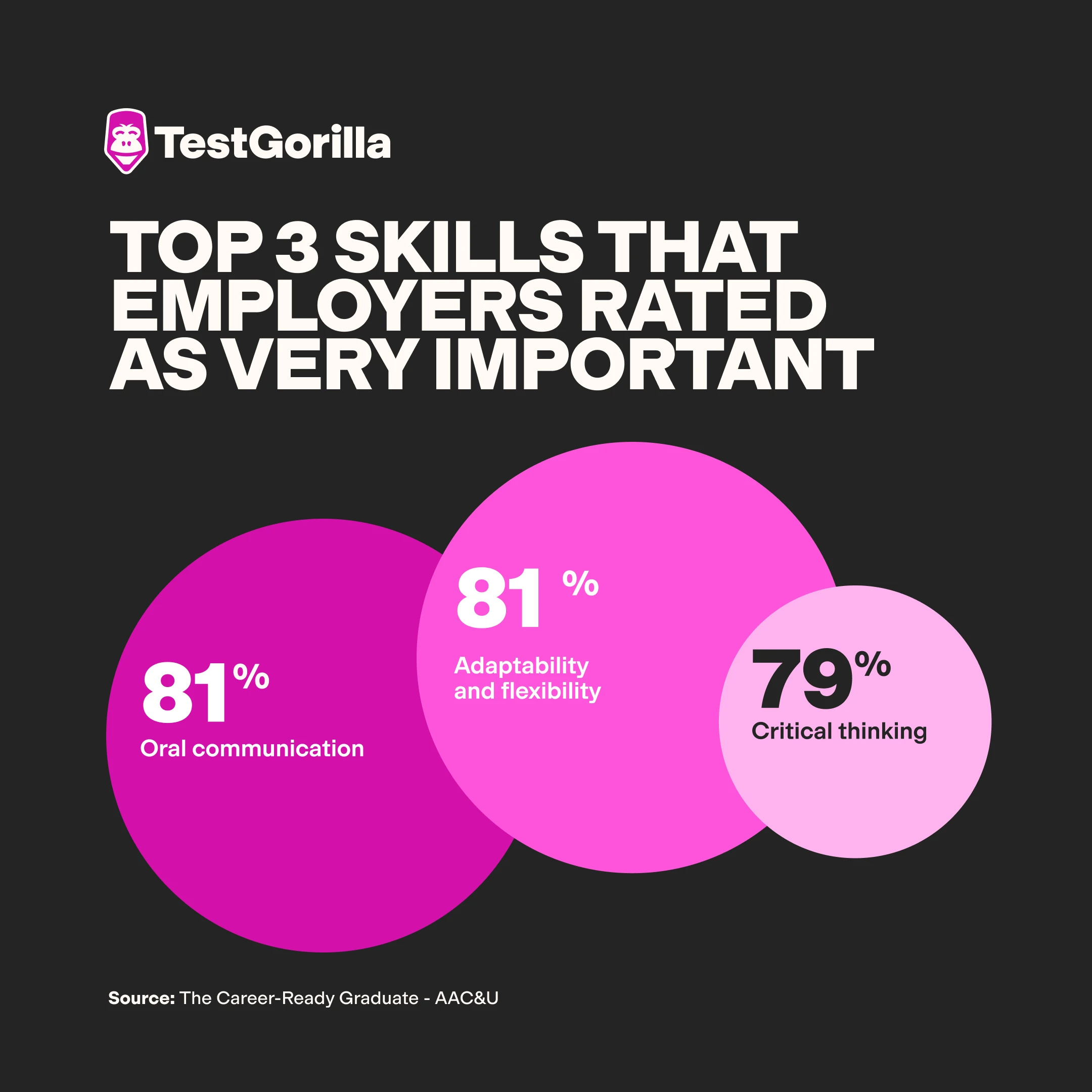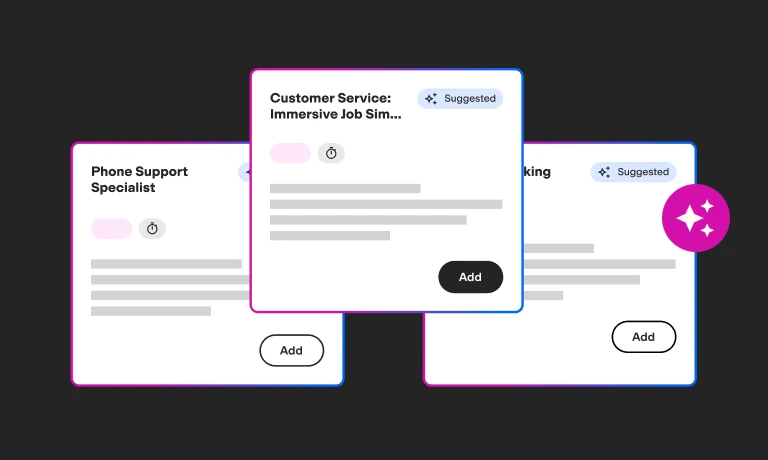Are graduates career-ready? 40% of employers don’t think so. What’s going on?
A recent survey revealed that over 60% of employers aren’t confident that their current talent pipeline solutions will meet their workforce needs in the next 5-10 years. One particular solution they're concerned about is the education-to-workforce pipeline – many employers (40%) feel that graduates aren’t career-ready when they join the workforce.[1]
Employers must do something about their lost confidence in the graduate pipeline. The question is – what?
In this article, we take a deep dive into the research to understand where this lost confidence has come from. We also look at ways to bridge the gap between employers and educators and rebuild trust in the graduate talent pipeline.
Table of contents
- What’s the problem?
- Why employers are worried about graduates not being career-ready
- Why are college grads unprepared for today’s workforce?
- What can employers do to rebuild confidence in the education-to-workforce pipeline?
- What else can employers do to meet future workforce needs?
- Closing the skills gap and building confidence
What’s the problem?
There’s a growing disconnect between education and industry: The learning outcomes in higher education don’t seem to match up with industry needs, and as a result, many graduates don’t seem to have the skills and experience employers seek. This has caused employers to lose confidence in the early-career talent pipeline that so many of them rely on.
The issue was recently highlighted in YouScience’s 2024 Workforce Report, which surveyed 500 HR professionals and business leaders across various industries. Worryingly, 40% of employers feel educational institutions don’t adequately prepare students for careers in their fields. Seven percent said graduates are “not at all prepared.”
2023 research by the American Association of Colleges and Universities (AAC&U) that involved 1,010 employers backs this up. Only 48% of employers strongly agree that higher education prepares students to succeed in entry-level positions, while just 41% strongly agree that it prepares students to advance in the company.
Education providers and employers perceive the situation differently. Harvard Business School and the American Association of Community Colleges (AACC) conducted joint research involving 800 business leaders and 347 community college leaders. While 80% of community college educators feel they produce work-ready graduates, only 62% of employers think the same way.
So, what about students? They feel similarly to employers.
For its 2022 Graduate Employability report, Cengage Group spoke with 1,000 current and recent graduates. A worrying 48% didn’t apply for entry-level positions because they felt they weren’t qualified enough. Thirty-nine percent said this was because they didn’t have all the skills listed in the job description.
Why employers are worried about graduates not being career-ready
This lack of confidence in new grads – and a critical talent pipeline – is especially concerning in the context of the current labor shortages many companies face. Across the board, employers are trying to find ways to manage workforce gaps. In the US, there are 8 million job listings – yet only 6.8 million unemployed workers.
According to the US Chamber of Commerce, the education and health services and the professional and business services sectors have the highest numbers of job openings. These are industries where many roles require some level of post-secondary qualifications.
Employers are looking for qualified people, and recruiting graduates is an obvious means of finding talent. However, college grads who are ill-prepared for the workforce can disrupt companies’ operations, often require additional training, and increase onboarding costs.
The best insights on HR and recruitment, delivered to your inbox.
Biweekly updates. No spam. Unsubscribe any time.
Why are college grads unprepared for today’s workforce?
Here are some underlying factors that may be contributing to the lack of industry-preparedness of recent graduates.
1. Skills gaps
At the heart of this issue is a disconnect between the skills students develop during their studies and the skills employers need. This is evident in the training needs employers report for their newly hired graduates.
According to YouScience’s 2024 Workforce Report, 86% of employers reported that entry-level hires need further training to succeed, with 26.9% saying they required a lot of extra training.
Soft skills – general, psychosocial skills necessary regardless of the role or industry – are a particular issue. While higher education often focuses on technical skills and theoretical knowledge, employers feel some students lack the essential soft skills needed to thrive in the workplace.
According to AAC&U’s 2023 report, the top three skills that employers rated as very important are:
Oral communication (81%)
Adaptability and flexibility (81%)
Critical thinking (79%)
However, when asked whether students were very prepared in relation to these skills, only about half of employers said they were.
2. Rapidly evolving nature of skills
Some major skills gaps result from rapidly evolving industries and skills. It’s worth taking a closer look at this specific issue.
The higher education system is heavily regulated (as it should be). It’s also a large beast. As of 2022, there were 15.397 million students enrolled in colleges alone.
As a result, it’s difficult for colleges to quickly change gears and respond to new and emerging skills employers need. Even if education providers wanted to offer courses on these emerging skills, these courses would take time to develop and implement.
In the lag period, students may be learning outdated curricula and missing out on acquiring the expertise employers are looking for. While we’re not saying this is the case across the board, it’s something often seen in industries like tech.
A good example? AI. Despite being one of the most in-demand skills according to employers, many education providers have yet to incorporate it into their courses.
In Cengage Group’s 2024 Graduate Employability report – which surveyed 1,000 employers and 974 recent graduates – 73% of employers reported using generative AI (genAI). However, more than half of graduates (55%) reported that their program lacked any GenAI-relevant skills.
When the education sector struggles to keep up with the changing skills landscape, employers are faced with significant skills shortages. Sixty-eight percent of leadership responding to a Deloitte survey of 1,900 IT and business executives worldwide say they have moderate-to-extreme AI skills gaps.
Employers seem to want to recruit externally to fill this gap. According to the Deloitte survey, employers are 3.1 times more likely to hire new AI-ready talent than upskill their current employees. But how can they do this when graduates and entry-level applicants don’t offer the necessary skills?
3. Shift towards skills-based hiring
At the same time that graduates are leaving higher education with skill gaps, employers are moving towards skills-based hiring in large numbers.
With a skills-based approach, employers prioritize candidates’ abilities over their formal qualifications or previous job titles. This approach helps them find talent with specific and measurable job-related skills.
The State of Skills-Based Hiring 2025 found that 85% of employers we surveyed report they’re now using skills-based hiring. Compare this with 2023, where this figure was 73%, or 2022, where it was just 56%.
53% of employers are even completely removing degree requirements from job postings in their skills-based hiring efforts.
Perhaps partially as a result of the surge in skills-based hiring, some employers are also demonstrating a strong preference for practical experience over theoretical knowledge. YouScience’s research found that 31% of employers feel practical experience is more important than academic qualifications.
Skills-based hiring itself isn’t the problem – we’re big fans, of course! It’s a great way to remove bias from hiring, identify top talent, and reveal other sources of talent – like STARS (workers skilled through alternative routes), neurodiverse individuals, and fair chance hires with minor criminal records.
And when used correctly, it can undercover entry-level hires with the expertise or adjacent skills – skills closely related or complementary to the skills you’re looking for – that you may otherwise overlook.
However, given that graduates are leaving secondary education with fewer skills than employers expect, entry-level talent pipelines could shrink if employers don’t take a considered approach to skills-based hiring (more on how to do this below).
4. Lack of collaboration between employers and education providers
What makes this issue worse? Employers and educators are failing to communicate with each other effectively. This results in a large gap between what education providers believe employers and industries require and what they actually need.
According to Harvard Business School and AACC research, only one in four employers openly discuss their hiring needs with educators. Highlighting the disconnect that results, the study found that while 28% of employers graded themselves an ‘A’ for collaboration with colleges, only 7% of educators graded employers an ‘A.’”
What can employers do to rebuild confidence in the education-to-workforce pipeline?
The current situation is lose-lose-lose. The lost confidence in the graduate pipeline may result in fewer entry-level hires. A decline in graduate hires may devalue the qualifications education providers offer. And, at the end of the day, young people, ready and raring to enter the workforce, are having a more difficult start to their careers.
Below, we aim to provide some food for thought about these issues and some approaches educators and employers could consider.
1. Collaborate, collaborate, and collaborate
Collaboration is key to solving this issue and finding opportunities that benefit employers, education providers, and graduates.
Open and ongoing dialogue allows employers and educational institutions to talk about emerging skills and ways to give students access to practical experience that complements their education and prepares them for the workforce. Plus, employers and education providers can build formal partnerships, resulting in initiatives and career pathways like internship programs.
Expanding this relationship may also identify out-of-the-box solutions. For example, AAC&U proposes microcredentials – short, accelerated certifications in specific skills. The organization says, “Our research echoes that of others in suggesting microcredentials should be a growing priority for colleges and universities in helping students to both build and signal skill attainment.”
2. Expose students to career pathways as early as possible
According to YouScience, 63% of employers engage with students only after they’ve graduated high school.
However, research shows that the earlier you expose students to potential career pathways, the better. Employers should be looking beyond postsecondary education providers and consider how to connect with high school and even middle school students.
A survey by the American Student Association (ASA) of 611 Gen Zs found that 69% of current high school students feel they would’ve “really benefited from more career exploration opportunities in middle or high school.” According to ASA, “Middle school is a critical time to begin self-discovery and career exploration activities… high school is too late to allow for ample discovery, experiences, and time to fail safely.”
High school students are especially interested in hearing from employers. In a survey by Pearson’s Connections Academy of 1,019 US students in grades 8-12, 49% said they want to know which skills employers are looking for, and 46% want to access information about work experience internships and apprenticeships.
Employers already recognize this. Ninety percent of employers that spoke to YouScience for its report highlighted that better partnerships with K-12 schools and postsecondary institutions would help their long-term talent pipelines.
3. Consider all entry-level talent pipelines
The prospect of massive student debt and the shift towards skill-based hiring has encouraged many younger people to consider attending vocational programs, such as trade schools, community colleges, online courses, and boot camps.
Speaking to CNBC, Ed Grocholski, CMO at Junior Achievement, says, “While cost is a factor, there’s also the recognition that you may not necessarily need a college degree to be successful.”
This resonates deeply with Gen Z, who’s been coined the “tool belt generation.”
Research by Validated Insights found that the number of students enrolling in trade school increased 4.9% between 2020 and 2023, while university enrollments fell 0.6%. According to an analysis by the National Student Clearinghouse Research Centre, over half (55.7%) of graduate enrollment growth in spring 2024 was due to increased community college enrollment.
Offering students a quicker path to earn an income while providing them with practical experience, vocational programs can be a great source of talented candidates.
Employers should ensure their pipeline strategies include various forms of entry-level talent – from vocational program graduates to self-taught individuals to skilled people with some community college courses under their belts – and not just college grads.
4. Take a careful approach to skills-based hiring
Until educational institutions and employers are more aligned, recent graduates may need a lot of training and development – perhaps more than some employers want to give them. But if you hire the right people and invest in the right training, you’ll set your company up for success.
Skills-based hiring is a great way to learn more about the professional development needs of graduate and entry-level candidates. You can use skills-based hiring methods – like candidate skills assessments – to understand candidate skills gaps better and develop meaningful, targeted onboarding and training for new hires.
You can also use it to identify candidates who may not have all the specific technical skills needed for a role – which can easily be taught – but offer soft skills (which can’t easily be taught) that make them more than capable of succeeding in the role. For example, assessing adaptability, trainability, and culture add can help you see the potential of graduate candidates you otherwise may have passed over.
These strategies are good examples of taking a considered approach to skills-based hiring, as we mentioned earlier. They help you fully explore the skills of the graduate talent pipeline and uncover more candidates.
What else can employers do to meet future workforce needs?
Of course, employers shouldn’t be over-reliant on entry-level talent to meet their workforce needs. There are various other methods of finding talent to fill open positions. Here are just a few:
Upskilling and reskilling current employees
Opening up more opportunities for remote talent from around the globe
Attracting skilled talent by understanding what employees want from “good employers”
Closing the skills gap and building confidence
There’s no quick fix to the growing disconnect between employers and education providers. However, there are many potential opportunities for the two to explore via collaboration.
Employers should also broaden their reach to connect with middle and high school students, take a considered approach to skills-based hiring, and include all types of education providers when fostering entry-level pipelines.
Together, educators and employers can bridge the divide and help build a pipeline of skilled and job-ready graduates.
Source
[1] YouScience, 2024 Workforce Report: Fixing America’s Broken Talent Pipeline, https://www.youscience.com/resources/reports/fixing-americas-broken-talent-pipeline-bridging-education-and-industry-for-workforce-success/.
You've scrolled this far
Why not try TestGorilla for free, and see what happens when you put skills first.




















